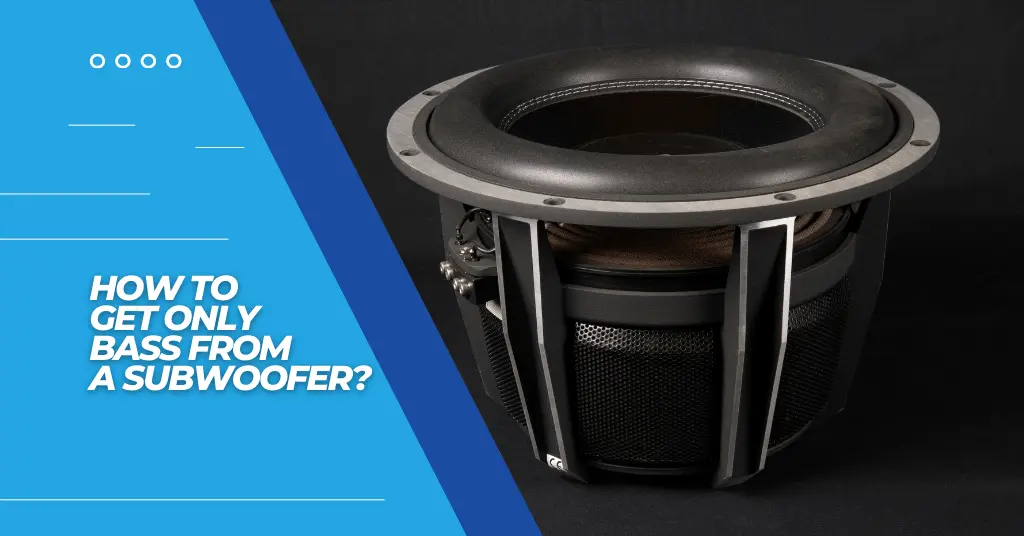How to Get Only Bass From a Subwoofer?

Some people only want to hear the bass from their subwoofer, and that’s okay! Let’s be a friend if you’re one of those audiophiles. As you know, subwoofers are designed to reproduce low-frequency sounds too deep for regular speakers (Bass is perfect for movie sound effects).
However, it can be a bit challenging to get the best sound from your subwoofer if you don’t really know what you’re doing with your home or car audio system.
Fortunately, you’re my friend, and that’s why I’m sharing with you all of my favorite steps to get those low-end frequencies to come through loud and clear without any distortion or muddiness. Let’s begin!
Does a Subwoofer Only Play Bass?
Before we go any further, I want to ensure some essential things. A subwoofer is designed to produce low-frequency sound, commonly called “bass.”
Generally saying, the low-frequency range of a subwoofer can start at around 20Hz and extends up to 200Hz. While subwoofers can also produce other frequencies, their main focus lies on bass output.
That’s why audiophiles use subwoofers to enhance the audio experience in home theater or car audio systems. Subwoofers provide high-quality sonic results when paired with other speaker types like tweeters or mid-range speakers, making them an essential part of any quality sound system setup.
My Favorite 9 Steps to Get Only Bass From Subwoofer:
Now that you know about something fundamental! Let me share with you some steps to get only bass from the subwoofer:
1. Choosing the Right Subwoofer:
Please understand this point carefully! You must choose the right subwoofer if you’re looking for the bass sound you desire. Not all subwoofers can produce the same type or quality of bass, so that an ill-suited model may deliver distorted or weak bass.
Moreover, when selecting a subwoofer suited to your specific needs, you must remember the size, sensitivity, enclosure type, power handling, and budget.
For example, if you want powerful, deep bass, you must choose a car subwoofer with a low-frequency range and a high power handling capacity. Ultimately, getting the right subwoofer is crucial to enjoying good-quality bass without distortion.
2. Placing the Subwoofer for Optimal Bass Output:
I’ve seen many people talking about the subwoofer placement. For them, the placement doesn’t matter, which is totally wrong! The placement plays one of the core roles in getting the best bass output from the sound system. Please read the below points:
2.1 Subwoofer Placement in Car Audio System:
Ideally, you should place subwoofers close to the primary listening position so that you can only hear the bass from the subs. Subwoofer placement can affect audio quality and response time, so it is essential to get it right.
Another thing to consider when placing a subwoofer in your car is the distance from the other speakers. The ideal distance between a subwoofer and front or rear speakers should be 10-18 inches.
2.2 Subwoofer Placement in Home Theater System:
If I were in your shoes, I would position the subwoofer near the front and center of the room to give you better audio quality while isolating low frequencies from other speakers.
Additionally, placing it closer to walls can help produce more bass due to sound reflection. Lastly, ensure that no furniture or objects block sound waves from your subwoofer. This will ensure optimal music quality with enhanced bass tones.
3. Setting the Right Crossover Frequency:
It is also essential to set the right crossover frequency on a subwoofer to make it deliver the desired low frequencies. This will help prevent distortion from sounds outside its frequency range and ensure your subwoofer gets a maximum bass response.
Setting a car subwoofer crossover frequency of around 80Hz should provide excellent results for bass-heavy music and other low-frequency waves. It will also minimize interference between speakers in a multi-speaker sound system and can help improve overall audio quality.
4. Setting the Phase:
When you set the phase to 0 degrees or 180 degrees if out of phase with other speakers, it allows sound waves to travel in and out simultaneously, creating a more accurate and consistent sound.
This helps produce strong bass tones that are easily distinguishable from the rest of your audio system. Furthermore, setting the correct phase can also help prevent possible disruption caused by the cancellation of specific frequencies, which may otherwise result in poor-quality sound reproduction.
5. Adjusting the Volume Level:
You can start at a low volume setting and gradually increase it and stop until all frequencies are balanced and your music sounds great with powerful bass notes.
Adjusting the volume level also prevents damage to your speakers due to loud playback, which would lessen the power of your audio system’s low-end performance. Setting the volume results in a cleaner and more nuanced bass response with better clarity.
6. Adjusting the Low Pass Filter:
While crossover and LPF are not the same, you can play with a low-pass filter if you don’t have a crossover feature on the amplifier. Anyway, setting the low pass filter to 80Hz will work like a charm because it ensures that only the lowest frequencies are sent to your subwoofer.
This allows you to enjoy bass-heavy music without other high-frequency sounds interfering with and overpowering the bass. Having a correctly set low pass filter also helps prevent distortion due to subwoofer clipping, when too much volume causes sound waves of different frequencies to overlap and distort each other.
Adjusting the low pass filter on your subwoofer ensures you will get clean, crisp, powerful bass from your music or movie audio.
7. Adjusting the Subwoofer Gain:
With the subwoofer gain help, you can make sure that every instrument in your music sounds balanced and also maintains a good level of audio quality.
You can also use a sound meter to measure decibels and adjust the gain until you get the desired output. By setting up the correct output, you can ensure that no other frequencies (from other instruments) interfere with your bass sound!
8. Adjusting the Bass Boost:
In the end, adjusting the bass boost is essential to ensure you get the right balance of low-frequency output from your subwoofer. The bass boost feature increases the lower frequencies in sound and can emphasize the deep, rumbling tones that a subwoofer produces.
This allows you to customize your listening experience for full-range audio or just the deep, satisfying bass effect. However, too much bass boost will create distortion and reduce overall sound quality, so it’s best to be mindful when adjusting this feature.
9. It’s Time to Test Bass Output From the Subwoofer:
Now, you can play some test tracks with different frequencies at various volumes. While playing, make any necessary tweaks so that the sound is balanced and optimized for your environment.
To check if the subwoofer is working correctly, you can use a sound meter to measure decibels from each speaker to see how much bass output you are getting.
3 Tips to Get Loud Bass From Subwoofer:
Here are some tips to get loud bass from the car subwoofer:
1. Use Sound-Deadening Material:
Sound-dampening materials can make a huge difference in controlling the loud bass noise from your car or truck’s audio system. These materials absorb and dissipate sound energy, helping to reduce bass resonance and increase clarity.
Such products come in different shapes and sizes and are usually made of metalized foam, fabric barrier matting, vinyl liners, and dyna-mat products. Installing sound-dampening material also helps provide a loud bass outside the car— all for a better auditory experience!
2. Use External Amplifier for Passive Sub:
A passive subwoofer with an external amplifier can give you louder and clearer bass than if left unamplified. The amplifier will drive more power to the speaker, allowing it to move more air and produce higher sound pressure levels.
Additionally, having an amp gives you more control over the bass output so that you can tweak and fine-tune your sound system for maximum performance.
You’ll also be able to access advanced features such as low-pass filters, crossover frequencies, phase control, etc., which can help improve how accurately your sound system reproduces bass frequencies.
(Passive subwoofers can produce more powerful low-frequency sounds than active subwoofers if tuned with quality external amplifiers)
3. Importance of Proper Tuning and Settings:
Proper tuning ensures that the signal reaches all parts of the frequency range. Setting up the correct crossover means that frequencies are not sent to speakers or components that cannot handle them.
This helps keep distortion low and allows for a clean, tight sound with powerful bass output. Additionally, carefully selecting an amplifier gain will help ensure you don’t overpower your speakers with too much signal while providing sufficient power to get the full performance out of your subwoofer.
General FAQs
How Do I Isolate Bass to My Subwoofer?
Adjust your amplifier or receiver’s low pass filter and crossover settings to isolate bass to a subwoofer. Adjust the volume and phase knob until you get the desired effect.
How Do I Get Deep Low Bass From My Subwoofer?
You should adjust the equalizer settings or use a bass booster to achieve deep, low bass from your subwoofer.
What Hits Harder, 2 Ohm or 4 Ohm?
When it comes to sound, a 2-ohm speaker will hit harder than a 4-ohm speaker. A 2-ohm speaker requires less power from the amplifier to reach its full potential, whereas a 4-ohm speaker needs more power.
